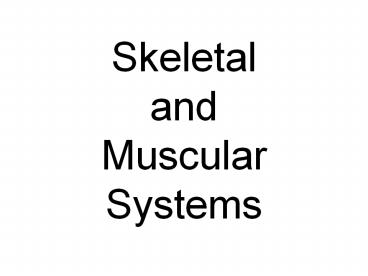Skeletal and Muscular Systems - PowerPoint PPT Presentation
1 / 11
Title:
Skeletal and Muscular Systems
Description:
Skeletal and Muscular Systems Skeletal System Functions Gives structure to the body Supports Muscles Protects organs Organs There are 206 bones in the body. – PowerPoint PPT presentation
Number of Views:56
Avg rating:3.0/5.0
Title: Skeletal and Muscular Systems
1
SkeletalandMuscularSystems
2
Skeletal System
3
Functions
- Gives structure to the body
- Supports Muscles
- Protects organs
4
Organs
- There are 206 bones in the body.
- Layers of bone
- Periosteum bone membrane
- Compact Bone hard part of the bone that
provides support. - Spongy Bone framework of the bone that
makes bone light and strong. - Bone Marrow produces blood cells and stores
energy.
5
Bone Structure
Periosteum
Marrow
Bony layer
Blood vessels
6
Structures
- Joint place where bones are connected
- Ligament tough bands of tissue that hold
joints together. - Tendon cords that connect muscle to bone
7
How It Works
- Muscles are connected to bones. When they cross
a movable joint, they act to move it. - Types of Joints
- Ball-and-socket Joint shoulder and hip
- Pivot Joint top two vertebrae and elbow
- Hinge Joint knee and elbow
8
Muscular System
9
Function
- Movement of the body
- Protection of the joints
- Heat creation
10
Organs
- Muscles are made up of long paired strands of
proteins. - Types of muscles
- Skeletal Muscle voluntary muscle that
moves the body. - Smooth Muscle involuntary muscle that lines
internal organs found in digestive tract and
blood vessels. - Cardiac Muscle muscle that is specific to the
heart.
11
How It Works
- Muscle can only contract and relax. Joints are
moved by shortening muscles. - Muscles work in tandem. This is called
reciprocal innervation. One muscle contracts on
one side of the joint while the muscle on the
other side relaxes.































